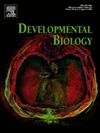雌性成年果蝇生殖系干细胞维持需要雌激素相关受体。
IF 2.5
3区 生物学
Q2 DEVELOPMENTAL BIOLOGY
引用次数: 0
摘要
成人组织的功能依赖于内在因素,这些内在因素介导干细胞自我更新和增殖,以响应生理和环境的变化。孤儿核受体的雌激素相关受体(ERR)亚家族是代谢和动物生理的主要转录调节因子。在哺乳动物中,ERRs (NR3B1, NR3B2, NR3B3)在调节线粒体生物合成,脂质代谢以及干细胞维持中发挥作用。唯一的果蝇ERR同源基因通过在胚胎发生的后半段建立代谢状态来促进幼虫的生长。此外,成年雄性果蝇需要ERR来协调糖酵解代谢和脂质合成,并在睾丸内调节精子发生基因的表达和生育。尽管大量的工作描述了ERR在果蝇代谢中的作用,但ERR是否在调节干细胞行为方面具有保守的要求尚未得到充分研究。为了确定ERR是否调节果蝇的干细胞活性,我们使用已建立的成年雌性生殖系干细胞(GSC)谱系作为模型。我们发现,使用条件热休克驱动的FLP-FRT重组,在成年女性中全身敲除ERR显著降低GSC数量和GSC中糖酵解酶的表达。此外,我们发现ERR活性在成年女性生殖系中是维持GSCs所需的细胞自主活性;而ERR对GSCs的调节独立于其在成年女性脂肪细胞中的活性。我们的研究结果强调了ers在干细胞自我更新调节中的古老而保守的作用。本文章由计算机程序翻译,如有差异,请以英文原文为准。
Estrogen-related receptor is required in adult Drosophila females for germline stem cell maintenance
Adult tissue function is dependent on intrinsic factors that mediate stem cell self-renewal and proliferation in response to changes in physiology and the environment. The estrogen-related receptor (ERR) subfamily of orphan nuclear receptors are major transcriptional regulators of metabolism and animal physiology. In mammals, ERRs (NR3B1, NR3B2, NR3B3) have roles in regulating mitochondrial biosynthesis, lipid metabolism, as well as stem cell maintenance. The sole Drosophila ERR ortholog promotes larval growth by establishing a metabolic state during the latter half of embryogenesis. In addition, ERR is required in adult Drosophila males to coordinate glycolytic metabolism with lipid synthesis and within the testis to regulate spermatogenesis gene expression and fertility. Despite extensive work characterizing the role of ERR in Drosophila metabolism, whether ERR has a conserved requirement in regulating stem cell behavior has been understudied. To determine whether ERR regulates stem cell activity in Drosophila, we used the established adult female germline stem cell (GSC) lineage as a model. We found that whole-body ERR knockout in adult females using conditional heat shock-driven FLP-FRT recombination significantly decreases GSC number and glycolytic enzyme expression in GSCs. In addition, we found that ERR activity is required cell-autonomously in the adult female germline for maintenance of GSCs; whereas ERR regulation of GSCs is independent of its activity in adult female adipocytes. Our results highlight an ancient and conserved role for ERRs in the regulation of stem cell self-renewal.
求助全文
通过发布文献求助,成功后即可免费获取论文全文。
去求助
来源期刊

Developmental biology
生物-发育生物学
CiteScore
5.30
自引率
3.70%
发文量
182
审稿时长
1.5 months
期刊介绍:
Developmental Biology (DB) publishes original research on mechanisms of development, differentiation, and growth in animals and plants at the molecular, cellular, genetic and evolutionary levels. Areas of particular emphasis include transcriptional control mechanisms, embryonic patterning, cell-cell interactions, growth factors and signal transduction, and regulatory hierarchies in developing plants and animals.
 求助内容:
求助内容: 应助结果提醒方式:
应助结果提醒方式:


